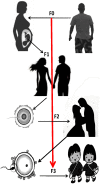Recent progress in epigenetics of obesity
- PMID: 36397166
- PMCID: PMC9670650
- DOI: 10.1186/s13098-022-00947-1
Recent progress in epigenetics of obesity
Abstract
Nowadays, obesity is one of the largest public health problems worldwide. In the last few decades, there has been a marked increase in the obesity epidemic and its related comorbidities. Worldwide, more than 2.2 billion people (33%) are affected by overweight or obesity (712 million, 10%) and its associated metabolic complications. Although a high heritability of obesity has been estimated, the genetic variants conducted from genetic association studies only partially explain the variation of body mass index. This has led to a growing interest in understanding the potential role of epigenetics as a key regulator of gene-environment interactions on the development of obesity and its associated complications. Rapid advances in epigenetic research methods and reduced costs of epigenome-wide association studies have led to a great expansion of population-based studies. The field of epigenetics and metabolic diseases such as obesity has advanced rapidly in a short period of time. The main epigenetic mechanisms include DNA methylation, histone modifications, microRNA (miRNA)-mediated regulation and so on. DNA methylation is the most investigated epigenetic mechanism. Preliminary evidence from animal and human studies supports the effect of epigenetics on obesity. Studies of epigenome-wide association studies and genome-wide histone modifications from different biological specimens such as blood samples (newborn, children, adolescent, youth, woman, man, twin, race, and meta-analysis), adipose tissues, skeletal muscle cells, placenta, and saliva have reported the differential expression status of multiple genes before and after obesity interventions and have identified multiple candidate genes and biological markers. These findings may improve the understanding of the complex etiology of obesity and its related comorbidities, and help to predict an individual's risk of obesity at a young age and open possibilities for introducing targeted prevention and treatment strategies.
Keywords: DNA methylation; Epigenetics; Histone modification; Obesity; miRNA.
© 2022. The Author(s).
Conflict of interest statement
The authors declare no competing interests.
Figures






Similar articles
-
Recent developments on the role of epigenetics in obesity and metabolic disease.Clin Epigenetics. 2015 Jul 11;7:66. doi: 10.1186/s13148-015-0101-5. eCollection 2015. Clin Epigenetics. 2015. PMID: 27408648 Free PMC article. Review.
-
Epigenetics and obesity cardiomyopathy: From pathophysiology to prevention and management.Pharmacol Ther. 2016 May;161:52-66. doi: 10.1016/j.pharmthera.2016.03.005. Epub 2016 Mar 22. Pharmacol Ther. 2016. PMID: 27013344 Review.
-
[Epigenetics of schizophrenia: a review].Encephale. 2014 Oct;40(5):380-6. doi: 10.1016/j.encep.2014.06.005. Epub 2014 Aug 12. Encephale. 2014. PMID: 25127897 Review. French.
-
Epigenetic regulation of insulin action and secretion - role in the pathogenesis of type 2 diabetes.J Intern Med. 2020 Aug;288(2):158-167. doi: 10.1111/joim.13049. Epub 2020 May 3. J Intern Med. 2020. PMID: 32363639 Review.
-
The effectiveness of web-based programs on the reduction of childhood obesity in school-aged children: A systematic review.JBI Libr Syst Rev. 2012;10(42 Suppl):1-14. doi: 10.11124/jbisrir-2012-248. JBI Libr Syst Rev. 2012. PMID: 27820152
Cited by
-
A Predictive Tool Based on DNA Methylation Data for Personalized Weight Loss through Different Dietary Strategies: A Pilot Study.Nutrients. 2023 Dec 6;15(24):5023. doi: 10.3390/nu15245023. Nutrients. 2023. PMID: 38140282 Free PMC article. Clinical Trial.
-
Molecular Mechanisms of Western Diet-Induced Obesity and Obesity-Related Carcinogenesis-A Narrative Review.Metabolites. 2023 May 21;13(5):675. doi: 10.3390/metabo13050675. Metabolites. 2023. PMID: 37233716 Free PMC article. Review.
-
Obesity: exploring its connection to brain function through genetic and genomic perspectives.Mol Psychiatry. 2025 Feb;30(2):651-658. doi: 10.1038/s41380-024-02737-9. Epub 2024 Sep 5. Mol Psychiatry. 2025. PMID: 39237720 Free PMC article. Review.
-
Epigenomic mechanisms of dietary prescriptions for obesity therapy.Epigenomics. 2025 Apr;17(6):423-434. doi: 10.1080/17501911.2025.2473309. Epub 2025 Mar 2. Epigenomics. 2025. PMID: 40025880 Review.
-
Targeting the Epigenetic Marks in Type 2 Diabetes Mellitus: Will Epigenetic Therapy Be a Valuable Adjunct to Pharmacotherapy?Diabetes Metab Syndr Obes. 2024 Sep 21;17:3557-3576. doi: 10.2147/DMSO.S479077. eCollection 2024. Diabetes Metab Syndr Obes. 2024. PMID: 39323929 Free PMC article. Review.
References
-
- GBD 2017 Risk Factor Collaborators Global, regional, and national comparative risk assessment of 84 behavioural, environmental and occupational, and metabolic risks or clusters of risks for 195 countries and territories, 1990–2017: a systematic analysis for the Global Burden of Disease Study 2017. Lancet. 2017;392:1923–1994. doi: 10.1016/S0140-6736(18)32225-6. - DOI - PMC - PubMed
Publication types
Grants and funding
LinkOut - more resources
Full Text Sources

